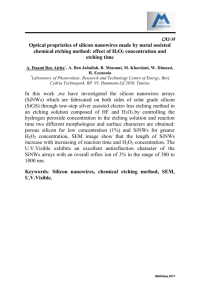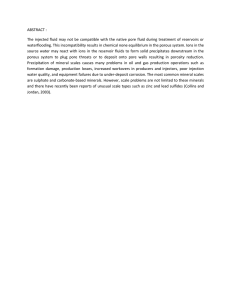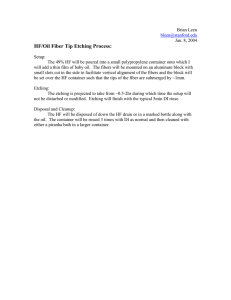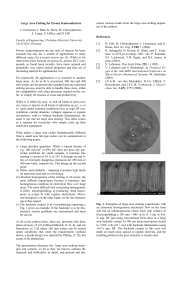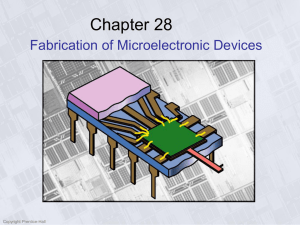- International Journal of Nanoscience and
advertisement
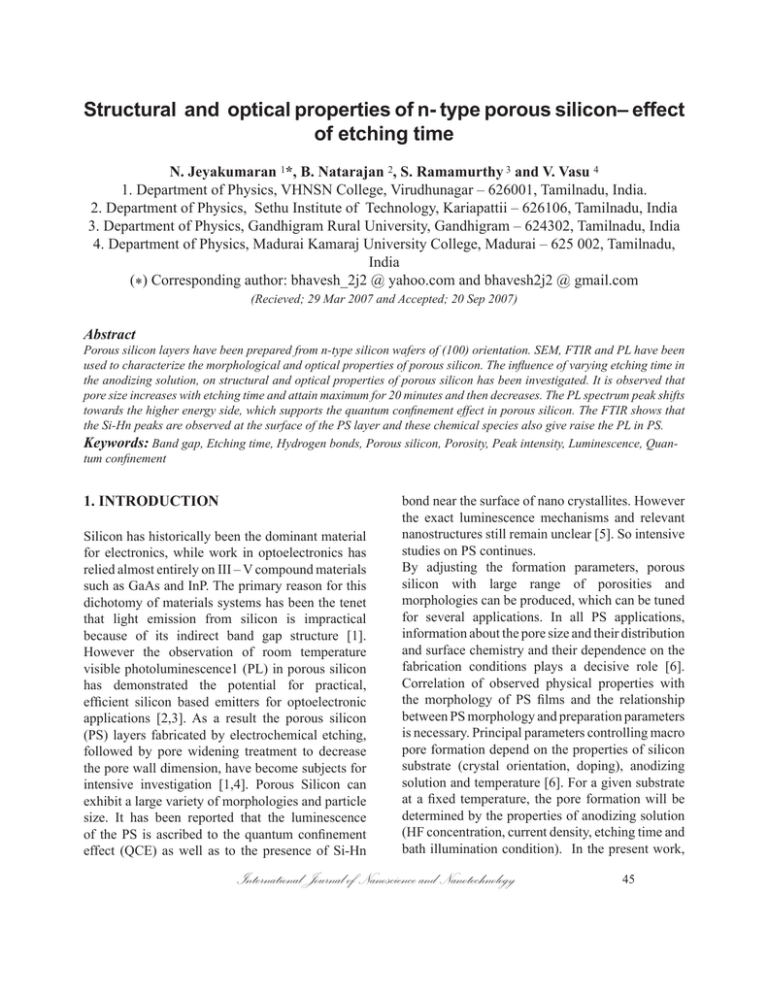
Structural and optical properties of n- type porous silicon– effect of etching time N. Jeyakumaran 1*, B. Natarajan 2, S. Ramamurthy 3 and V. Vasu 4 1. Department of Physics, VHNSN College, Virudhunagar – 626001, Tamilnadu, India. 2. Department of Physics, Sethu Institute of Technology, Kariapattii – 626106, Tamilnadu, India 3. Department of Physics, Gandhigram Rural University, Gandhigram – 624302, Tamilnadu, India 4. Department of Physics, Madurai Kamaraj University College, Madurai – 625 002, Tamilnadu, India (*) Corresponding author: bhavesh_2j2 @ yahoo.com and bhavesh2j2 @ gmail.com (Recieved; 29 Mar 2007 and Accepted; 20 Sep 2007) Abstract Porous silicon layers have been prepared from n-type silicon wafers of (100) orientation. SEM, FTIR and PL have been used to characterize the morphological and optical properties of porous silicon. The influence of varying etching time in the anodizing solution, on structural and optical properties of porous silicon has been investigated. It is observed that pore size increases with etching time and attain maximum for 20 minutes and then decreases. The PL spectrum peak shifts towards the higher energy side, which supports the quantum confinement effect in porous silicon. The FTIR shows that the Si-Hn peaks are observed at the surface of the PS layer and these chemical species also give raise the PL in PS. Keywords: Band gap, Etching time, Hydrogen bonds, Porous silicon, Porosity, Peak intensity, Luminescence, Quantum confinement 1. INTRODUCTION Silicon has historically been the dominant material for electronics, while work in optoelectronics has relied almost entirely on III – V compound materials such as GaAs and InP. The primary reason for this dichotomy of materials systems has been the tenet that light emission from silicon is impractical because of its indirect band gap structure [1]. However the observation of room temperature visible photoluminescence1 (PL) in porous silicon has demonstrated the potential for practical, efficient silicon based emitters for optoelectronic applications [2,3]. As a result the porous silicon (PS) layers fabricated by electrochemical etching, followed by pore widening treatment to decrease the pore wall dimension, have become subjects for intensive investigation [1,4]. Porous Silicon can exhibit a large variety of morphologies and particle size. It has been reported that the luminescence of the PS is ascribed to the quantum confinement effect (QCE) as well as to the presence of Si-Hn bond near the surface of nano crystallites. However the exact luminescence mechanisms and relevant nanostructures still remain unclear [5]. So intensive studies on PS continues. By adjusting the formation parameters, porous silicon with large range of porosities and morphologies can be produced, which can be tuned for several applications. In all PS applications, information about the pore size and their distribution and surface chemistry and their dependence on the fabrication conditions plays a decisive role [6]. Correlation of observed physical properties with the morphology of PS films and the relationship between PS morphology and preparation parameters is necessary. Principal parameters controlling macro pore formation depend on the properties of silicon substrate (crystal orientation, doping), anodizing solution and temperature [6]. For a given substrate at a fixed temperature, the pore formation will be determined by the properties of anodizing solution (HF concentration, current density, etching time and bath illumination condition). In the present work, International Journal of Nanoscience and Nanotechnology 45 Figure 1: SEM pictures of porous silicon samples formed with a) 10, b) 20, c) 30 and d) 40 minutes of etching time an attempt has been made to study the relationship linking the morphology, optical properties and fabrication conditions of porous silicon formed using n-type material. 2. SAMPLE PREPARATIONS AND EXPERIMENTAL SETUP Porous Silicon samples were prepared from n-type Silicon wafers (100) orientation with a resistivity of 50 Ω cm. The samples have been prepared by keeping the HF: ethanol ratio and current density constant at 1:2 and 30 mA/cm2 respectively and varying the etching time and during anodization the wafer was illuminated by a halogen lamp of 300 W. After anodization the porous silicon samples were rinsed in ethanol. The etching time used for the anodizing process has a strong influence on the porous silicon properties [7]. So the etching time is to be varied to study its influence on the PS characteristics. The experimental data on the relationship between the etching time and the morphological and the optical properties are discussed in the following sections. 46 The photoluminescence (PL) spectra were recorded using Perkin Elmer LS 55 Luminescence Spectrometer in the emission range of 200 – 800 nm, fixing the excitation wavelength at 450 nm. The Fourier Transform Infra Red (FTIR) spectra of the samples were recorded using the Shimadzu FTIR8400S spectrometer in the range of 600 – 2400 cm-1 with a resolution of 4 cm-1. The Scanning Electron Microscope (SEM) analysis was carried out using Hitachi Scanning Electron Microscope - 450. 3.1. SEM studies: A detailed view of the surface morphology has been obtained using the Scanning Electron Microscope (SEM). Figs. 1a, b, c and d depict the SEM images of n-type porous silicon formed using different etching times of 10, 20, 30 and 40 minutes. It can be seen from the SEM picture in figure 1a, that when an etching time of 10 minutes is used fairly medium sized pores are formed; the pores are surrounded by thick columnar structure network of silicon walls. When the etching time is increased to 20 minutes, it can be seen from the SEM image IJNN,Vol.3, No.1, December 2007 Figure 2: PL spectra of Porous Silicon samples prepared using various etching time (figure 1b) that pores with maximum diameter are formed all over the surface region of the etched silicon layer. The pore size distribution is relatively uniform and the columnar walls are thin. The figure clearly indicates the sponge like structure of porous silicon layer. Pores with such characteristics will exhibit the quantum confinement effect (QCE) [5]. Further Kim et.al [7], found that the surface of the pore exhibits an etched layer containing aggregates of nanocrystallites and they also contended that it is likely that the intense PL at room temperature is attributable to the quantum confinement effect owing to the presence of aggregates in the etched layer of the PS. The average pore diameters are 2.1µm and 3.5µm at 10 and 20 minutes etching time respectively. Thus as the etching time increases, the average pore diameter also increases. The maximum average pore diameter obtained is comparable to the value reported by Kim et.al [5]. When the etching time is further increased to 30 minutes, the SEM image reveals that (Figure 1c) some of the pore walls break exposing a small portion of the next layer. When the anodizing time is still further increased to 40 minutes, the SEM image (Figure 1d) shows that, most of the pore walls have been broken exposing a major portion of the next layer. Thus the study shows that the pore size and hence the porosity of PS depends on the etching time i.e., the etching time is a parameter controlling the pore size hence the porosity of the PS. It can be further noted that even when the etching time is increased by 10 minutes beyond the etching time of 20 minutes which gives the maximum pore size, some of the pore walls alone break, exposing a small portion of the next layer; a further increase of 10 minutes in etching time (totally 40 minutes) is needed to break most of the thin pore walls and expose most part of the next layer. This can be interpreted to mean that the thin pore walls are strong. Such a conclusion is in excellent agreement with the report of Lehmann and Gosele [3] on the strength of the thin pore walls. 3.2. Photoluminescence (PL) spectral studies The photoluminescence (PL) spectra of the n-type porous silicon formed using different etching times of 10, 20, 30 and 40 minutes are displayed in figure 2. It can be seen that room temperature PL in the visible region has been obtained for all the etching times used. The PL intensity maximum has been found to occur at 624 nm and 619 nm for the etching times of 10 and 20 minutes respectively, indicating that there is a blue shift of the PL maximum with etching time. It is interesting to note that the maximum PL intensity of the PS sample increases with increasing anodizing time and attains maximum for the anodizing time of 20 minutes and the peak intensity International Journal of Nanoscience and Nanotechnology 47 Figure 3: FTIR spectra of Porous Silicon samples were prepared at various etching time (X-axis – 0 - 4 : Y-axis – 2400 – 600) falls for further increase in etching time, which shows that 20 minutes is the optimum etching time for the n-type silicon to prepare PS. It is highly likely that the increase of the PL intensity is caused by the increase in the total volume of the nanocrystallites on the surface of the PS [7]. When an etching time of 10 minutes is used, fairly medium sized pores are formed (SEM studies); this is supported by somewhat medium PL intensity. Increasing the etching time to 20 minutes, the pore size is maximum (SEM image); correspondingly the PL intensity is also maximum with a blue shift of the PL peak position. So it can be concluded that as the porosity of PS increases there is a blue shift of the PL peak position. Such a trend in PL peak position shifting to the blue side, with increasing pore size has been reported earlier [1-4, 6, 8]. The availability of room temperature PL emission in the visible range and a blue shift with porosity of PS are strong evidences for the quantum confinement effect (QCE) in porous silicon. According to Chen and Chen [9], when the etching time increases, electrons are confined to a narrower region as a result this 1.8 eV peak is blue shifted. As the etching time 48 is increased to 30 minutes, some pore walls break exposing a small region of the next layer. (SEM image). This is reflected in the PL spectrum by a marginal fall in intensity from the maximum. When the etching time is further increased to 40 minutes, most pore walls break, exposing a major portion of the surface of the next layer (SEM picture). This is evidenced in the PL spectrum by a sharp fall in intensity to a low value. 3.3. FTIR spectral studies Figure 3 represented the FTIR spectra of the ntype porous Si samples, prepared using different etching times of 10, 20, 30 and 40 minutes. The band assignments and vibration modes are given in Table.1 [10, 11, 12]. It is seen that all the samples with various anodizing times give rise to good absorption bands of same frequencies. The table.1 shows that, the large internal surface of these PS samples is covered with Si-Hn bonds, which provides a very good passivation of the defects and allows very attractive efficiencies to be obtained [13]. From the Figure3, it can be seen that, sharp IJNN,Vol.3, No.1, December 2007 Table 1: Observed surface bonding in the porous silicon layer absorption bands are obtained for the etching time of 20 minutes. Thus, same bands as for the HF concentration variation and current density variation cases have been obtained for the etching time variation cases also. Further from Figure 3, it can be seen that the absorption peak intensity increases with the increase of anodizing time and is maximum for the etching time of 20 minutes and then the intensity falls slightly for the etching time of 30 minutes and then falls sharply for the etching time of 40 minutes. This means that, the absorption peak intensity follows the similar trend as the PL peak intensity (figure 2 and 3) and so it can be taken that the surface passivation also plays a major role in determining the radiative efficiency of the porous layer. Kim.et.al [14], have also pointed out that the role of surface passivation is also very important in determining the radiative efficiency of the PS layer. 3.4. Aging studies of the PS samples The photoluminescence (PL) spectra of the ntype porous silicon samples after aging treatment for 1, 2, 3 and 4 weeks are displayed in figure 4. The PL intensity of the as-prepared PS has also been shown in the same figure. Room temperature PL in the visible region has been obtained for all the samples. From the figure.4, it can be seen that the PL intensity of PS has degraded after aging treatment for every one week. From the following FTIR figure 5, it can be noted that the intensity of the 1105-1150 cm-1 peak increases with increasing aging time, indicating that the porous silicon is oxidized due to aging and the degree of oxidation increases with increasing aging time. This peak at 1105-1150 cm-1, Si-O-Si asymmetric stretching mode vibrations, is dependent on the degree of oxidation of porous silicon. The remaining oxygen might have originated from the survived water in the pores of the porous silicon. The intensities of Si-Hn bands decrease with the aging time, meaning that the hydrogen on the PS surface desorbed during the aging. These conclusions are consistent with the conclusions arrived at by Chen Songyan ET al.[15], Zhao ET al [16] and Nakumara et al [17]. This oxidation layer does not seem to have good passivation of the dangling bonds, which in turn leads to poor radiative emission. When the PS sample exposed to aging, the intensities of FTIR signals from Si-Hn bands drastically reduced and the PL intensity falls due to depassivation. From the Figure 5, it can be seen that the intensities of Si- International Journal of Nanoscience and Nanotechnology 49 Figure 4: PL spectra of as-prepared PS and PS after aging. Figure 5: FTIR spectra for as prepared PS and PS after aging (X-axis – 0 - 3.5 : Y-axis – 2400 – 600) 50 IJNN,Vol.3, No.1, December 2007 Hn bands decrease with the increase of aging time. Thus the absorption peak intensity of Si-Hn bands follows more or less the same trend as the PL peak intensity (figures 4 and 5). So it can be assumed that the surface chemical composition also plays a major role in determining the radiative efficiency of the porous layers [14]. 4. CONCLUSION The SEM pictures show that by increasing etching time in the electrolyte the pores size are widened and attained the maximum at 20 minutes. The PL spectrum also gives that at the 20 minutes, the intensity attains the maximum value and the peak shifts towards the higher energy side, which supports the quantum confinement effect in porous silicon. The FTIR shows that the Si-Hn peaks are observed at the surface of the PS layer and these chemical species also give raise the PL in PS. References 1. L.T.Canham, Appl.Phys. Lett., 57, 1046, (1990) 2. A.Halimaoui, C.Oules, G.Bomchil, A.Bsiesy, F. Gaspard, R.Herino, M.Ligeon and F.Muller, Appl. Phys. Lett., 59, 304, (1991) 3. V.Lehmann and U. Gosele, Appl.Phys. Lett., 58, 856, (1991) 4. Y.Kanimitsu, H.Uto, Y.Matsumoto, T.Matsumoto, T.Futagi and H.Mimura Phys.Rev. B,48,2827,(1993) 5. D.A.Kim, S.I.Im, C.M.Whang, W.S.Cho, Y.C.Yoo, N.H.Cho, J.G.Kim and Y.J.Kwon, Appl. Surf. Sci, 230,125, (2004). 6. J.Dian, A.Macek, D.Nizansky, I.Nemec, V.Vrkoslav, T.Chvojka and I.Jelinek, Appl. Surf. Sci., 238, 169, (2004). 7. D.A.Kim, J.H.Shim and N.H. Cho, Appl. Surf. Sci., 234, 256, (2004). 8. R.P.Vasquez, R.W.Fauthauer, T.George, A.K.Sendzov and T.L.Lin, Appl. Phys. Lett., 60, 1004, (1992) 9. C.H.Chen and Y.F.Chen, Soli. Sta. Comm., 111, 681, (1999). 10. D.A.Papaconstanatopoulos and E.Economou, Phys.Rev.B,24,8233,(1981) 11. W.Y.Ching, D.J.Larn and C.C.Lin, Phys.Rev.B, 21,2378,(1980) 12. E.C.Freeman and W.Paul, Phys.Rev. B,20,716,(1979) 13. M.A.Hory, R.Herino, M.Ligeon, F.Muller, F.Gaspard, I.Mihalcescu and J.C.Vial, Thin solid Films, 255, 200, (1995). 14. Y.Y.Kim, K.W.Lee, S.Shim, S.H.Yang and S.H. Park, J. Korean Phy. Soc., 43(1), 170, (2003) 15. C.Songyan, P.K.Kashkarov, V.Y.Timoshenko, L.Baolin and J.Bingxi, Jour. Of Crys. Growth, 247, 445, 1, (2003). 16. Y.Zhao, D.Yang, D.Li and M.Jiang, Appl. Sur. Sci., 252,1065,(2005) 17. T.Nakamura, H.Omoya, K.Sasaki, N.Azuma and H.Mimura, Appl.Surf. Sci., 113/114, 145, (1997). International Journal of Nanoscience and Nanotechnology 51 52 IJNN,Vol.3, No.1, December 2007

